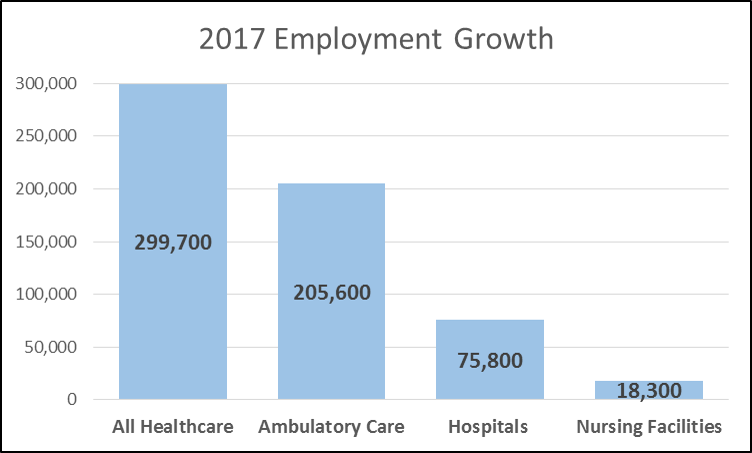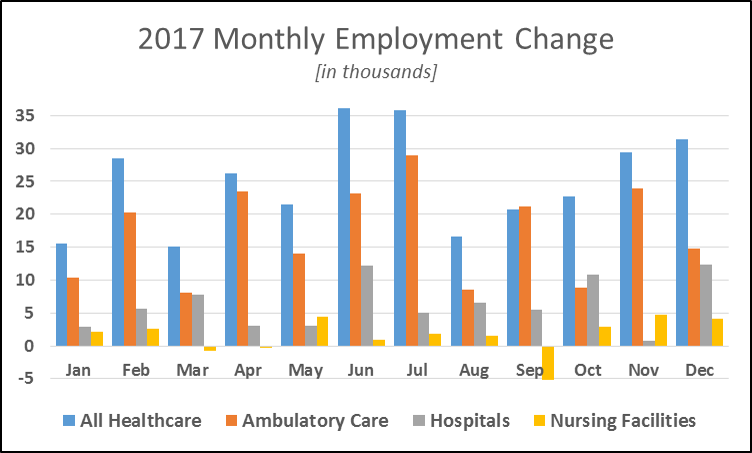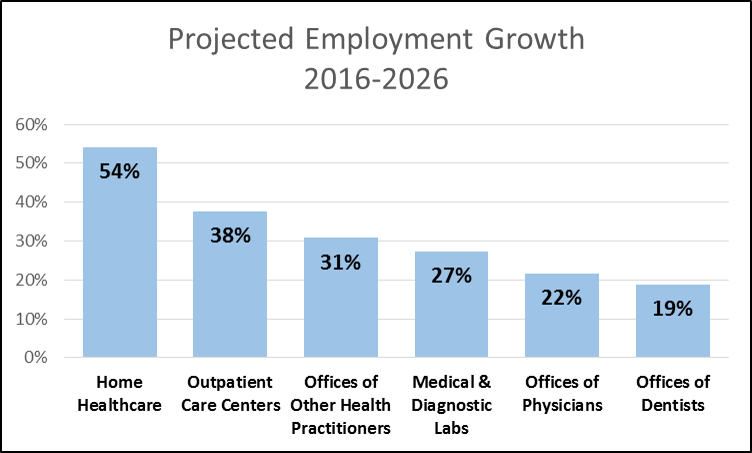
Healthcare Jobs in 2017: Rising Demand Overcame Policy Uncertainty
Any year that an industry adds 300,000 jobs is a good year.
Many thought the healthcare industry might not have a happy 2017, with the incoming presidential administration promising a sweeping change to the Affordable Care Act (ACA) through repeal and replacement with an undefined new policy. Throughout the year, an inconclusive debate raged over healthcare policy. While the ACA remains in effect, some changes were made that weaken it.
However, demand for healthcare services – and for the physicians, nurses, allied professionals and other healthcare workers who provide those services -- continued to be strong despite the policy debate. Recently released year-end data from the US Bureau of Labor Statistics showed that healthcare employment remained very healthy. While 2017 job growth didn’t quite reach the lofty levels of 2015 (383,000) or 2016 (379,000), it was a robust year nonetheless.

Ambulatory Care, generally defined as patient care and diagnostic providers that don’t have beds, is the largest employment subsector in healthcare, according to BLS tabulations, accounting for a total of 7.4 million jobs in December 2017. Hospitals employed approximately 5.2 million, while nursing and residential care facilities employed 3.3 million.
Ambulatory Care remains the most dynamic subsector of healthcare employment, consistently logging the biggest numbers in employment growth in the healthcare industry. The movement toward value-based care and preventing hospitalizations is a significant reason. Some of the fastest growing industries in the country – such as home healthcare, outpatient care centers, and medical and diagnostic laboratories – are included under Ambulatory Care.

While a slowdown in hospital-based jobs has been predicted, and hospital job growth in 2017 was 36% lower than in 2016, an increase of nearly 76,000 jobs last year is still significant. Concerns about hospital employment in 2018, especially in small towns and rural areas, are again being heard.
Forces driving long-range demand for healthcare workers remain very strong. In particular, the number of Americans who are 65 and older is projected to double in the next few decades; people 65 and older utilize significantly more healthcare services – and more complex services – than the general population, which will greatly increase demand for healthcare professionals who provide those services. Other drivers include the improving economy, which is expected to produce more than 10 million new jobs in the next decade. Increased employment means increased healthcare demand, because many of those jobs come with healthcare coverage, or they provide resources to pay for healthcare.
In addition, shortages of many types of healthcare professionals are expected to grow, including because of the retirement wave of Baby Boomers among physicians, nurses and allied health professionals. Replacement jobs will be a major factor boosting the numbers of job openings in healthcare.
The fastest rate of healthcare employment growth in the decade from 2016-2026 is expected in ambulatory care. In fact, one ambulatory care industry -- home healthcare -- is projected to be the fastest growing of any industry in the U.S. economy.

Healthcare employment has seen more than four years of continuous monthly net increases -- with only two months of net employment decreases in the past ten years. This historic upward trend is expected to continue for a decade or more.
Such projections of robust employment in healthcare should be good news – except that supply cannot meet demand for healthcare professionals. The gap between job openings and job hires in healthcare has widened, and long-range drivers of demand could continue that trend. Finding the quality practitioners they need will be a major challenge for many healthcare organizations.
[All data in this article is from the US Bureau of Labor Statistics.]


